Bedford Presbyterian Church (Bedford Village Historic District)
Introduction
Text-to-speech Audio
Constructed in 1871-1872, the Bedford Presbyterian Church is a dominant feature of Bedford’s Village Green. Designed by New York City architects David and John Jardine and built by the local firm of W.H. and C. Gedneyas, the Carpenter Gothic-style building was the fourth home of a devoted congregation that had been meeting in Bedford since the 1720s. On its exterior, the Bedford Presbyterian Church exhibits board-and-batten walls that create a pattern of light and shadow, producing a decorative effect. The church also possesses a square tower and a taller octagonal tower, both terminating in slate-covered spires. Services and programs are held regularly, which are attended by an active congregation. The Bedford Presbyterian Church is located in the Bedford Village Historic District, which was placed on the National Register of Historic Places in 1973.
Images
Bedford Presbyterian Church
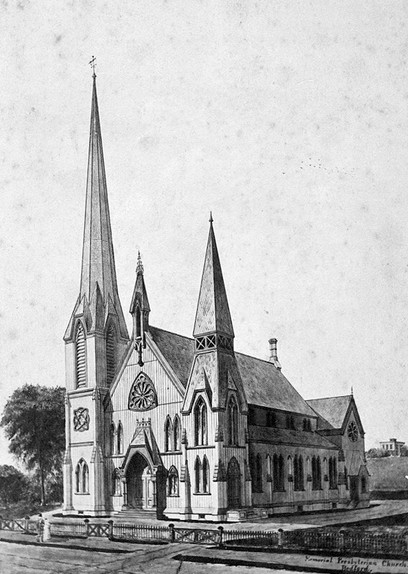
Bedford Presbyterian Church - 1976
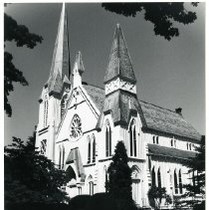
Bedford Presbyterian Church - 1982
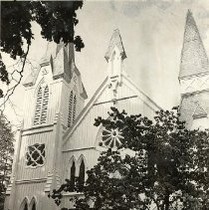
Bedford Presbyterian Church
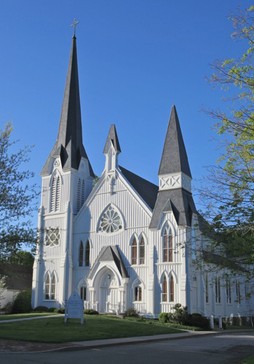
The 1783 Bedford Presbyterian Church - 1867

Bedford Village Green and Bedford Presbyterian Church
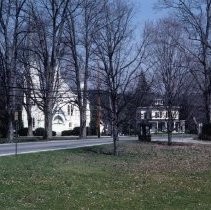
Backstory and Context
Text-to-speech Audio
Around the year 1689, approximately eight years after the original twenty-two founding men of Bedford established their village, a meetinghouse was constructed on the site of what is today the Bedford Historical Hall. The meetinghouse was used for town gatherings, including religious services, which in the early years catered to both Congregational and Anglican parishioners. Within a few decades, however, the services became primarily Presbyterian under the pastorate of the Rev. William Tennent, who came to Bedford in 1720 and later founded Pennsylvania’s Log College, the first theological seminary in North America serving Presbyterians.
In the early 1700s, the original 1689 meetinghouse was replaced by a second building, which was burned by the British during Tarleton's raid in 1779. A third building was erected in 1783 atop a hill to the west of the village. Because of the devastation and hardships of the recent war, the church was a very simple structure, unplastered and unpainted inside. In April of 1784 the first town meeting after the Revolutionary War was held in this rustic church building, at which time it was noted “that no persons that have been over to the enemy shall come into the town to reside; if any have already come in, they are to be immediately drove out...”
As the country recovered from war, so did Bedford, and the church became gradually more prosperous. In the early 1800s, one of the most illustrious members of “The Presbyterian Church and Congregation of Bedford” was John Jay (1745-1829.) Retired to Bedford, Jay had served as President of the Continental Congress, the second Governor of New York, and the first Chief Justice of the new nation’s Supreme Court. His gift to the church of silver communion ware is still displayed on the communion table of the church on most Sunday mornings. Jay later helped to found St. Matthews Episcopal Church, also in Bedford, but would return to the Presbyterian Church when the Episcopal pastor went to officiate in North Salem every third Sunday.
By 1870, the 1783 building that the Presbyterians had been using for services was in need of substantial repair. While plans were being made to raise funds for the restoration, a life-long member of the church, Mr. Francis Asbury Palmer, offered to finance the construction of a new building on land that he also donated. New York City architects David and John Jardine were hired to design the new church, which was built by the local firm of W.H. and C. Gedney. In total, Mr. Palmer, a descendant of one of the first settlers of Bedford, and his wife, would contribute $50,000 to cover the project. In return, Mr. Palmer required that the church do away with pew rentals and allow those without means to attend services along with everyone else so, “that the gospel may be preached to the poor.” (BPC, 1936 p.29)
For seven years after the old hilltop church was vacated, it stood closed except for occasional public meetings and concerts. After that, it was presented to Mr. Palmer, who had it moved about two miles north of the village. (BPC, 1936 p.29) Materials from the 1783 building were used for the construction of the Educational Center at Westmoreland Sanctuary in Mount Kisco.
The cornerstone of the new Bedford Presbyterian Church, a larger Carpenter Gothic-style building, was laid in June of 1871. Into the cornerstone was placed: a Bible; paper currency and gold coins dated 1871; newspapers and religious publications from the year; and the names of the architects, builders, masons, church elders, pastor, and the donors. The building was finished and dedicated in 1872 with much local fanfare.
The 1872 church building remains in use by the Bedford Presbyterian congregation. It is a substantial board-and-batten structure, the main (west) elevation of which is composed of the structures' pointed gable-end flanked by a square tower and a taller octagonal tower, both terminating in slate-covered spires. The interior of the church includes a Martin Pasi tracker organ which was installed in 1998. The Bedford Presbyterian Church is located in the Bedford Village Historic District, which was placed on the National Register of Historic Places in 1973.
Information and photos for this entry were contributed by the Bedford Historical Society. Special thanks to Lynn Ryan, Executive Director.
Sources
- Bedford Historical Society. Walking Tour of Historic Bedford Village. Bedford, NY.
- Bedford Historical Society website. https://www.bedfordhistoricalsociety.org/
- Bedford Presbyterian Church Anniversary Committee. Clark, Mary Agusta ed. Bedford Presbyterian Church, 1681-1936. Prepared on the Occasion of the 255th Anniversary Celebration, September 13, 1936. Bedford, NY: 1936.
- Bedford Tricentennial Committee. The Presbyterian Church and the Town of Bedford; 300 Years of Shared History. Bedford, NY. 1980.
- “Bedford Village Historic District #73001285.” National Register of Historic Places. United States Department of the Interior/National Park Service. 1973. https://catalog.archives.gov/id/75322953
- Lindefield Bianco, Shirley and Stockbridge, John. Images of America: Bedford. Charleston, SC: Arcadia Publishing. 2003.
- Westmoreland Sanctuary website. Accessed Nov 15, 2022. https://westmorelandsanctuary.org/environmental-education-center/
- Williams, Gray. Picturing Our Past: National Register Sites in Westchester County. Westchester County Historical Society. 2003.
Bedford Historical Society
Westchester County Historical Society
Westchester County Historical Society
Bedford Historical Society
Westchester County Historical Society
Westchester County Historical Society
